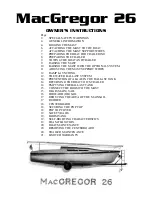
J/145 OWNER GUIDE
45
Electrical System
The following section describes the electrical systems aboard the boat, how they operate, where they
lead, and how to avoid trouble. Please read this section over more than once. For wiring code
information please refer to the color code diagram.
DC Electrical System
A 12 Volt DC electrical system is used throughout the J/145 for lighting and operation of pumps and
various accessories. The J/145 is standard with two 105 Amp batteries, and one 56 Amp 1,100 CCA
engine battery. An optional 210 amp AGM battery is available.
•
Electrical Panel:
is built by Bass
®
and controls electric distribution with circuit breakers and
switches. The main wiring harness runs from the back of this panel.
•
Mast Wiring Terminal Box:
is located in the shower compartment on the bulkhead. A wiring
harness exits the mast near the box, and is wired directly into the D.C. system through a terminal
strip. Once this wiring is installed, test each function to insure proper operation.
•
Battery Switch:
The battery switches (one for each house bank) are located under the
navigation table. They operate in either an ON or OFF position. The dedicated engine battery
switch is located in the aft cabin with it’s own switch.
•
There is a waterproof
Momentary Parallel Switch
located in the cockpit at the engine panel.
The purpose of this switch is to allow you to start the engine using the house bank should the
dedicated engine battery fail.
•
The
Alternator
is attached to the engine and creates a charging current only when the engine is
running. The output is to an automatic battery system located in the aft hanging locker that
distributes the current to the batteries as deemed necessary.
•
Accessories:
such as navigation instruments, stereos, radars, GPS can be added to the electrical
panel. Extreme care and forethought is necessary for installation as these are sensitive
instruments and require some measure of protection. Only professional marine electricians should
be contracted for such installations. Be sure all sensitive accessories are not only grounded
properly but that “fast blow” fuses are run off the panel for extra insurance against damage.
110 VAC Shorepower System
The 110 VAC shore power system is functional only when the boat is plugged into suitable power from
shore. The cord provided has the standard end for 30 amperage service. The boat end of the cord plugs
into the inlet on the transom. Ensure the plug prongs match those on the inlet, insert and twist to lock.
Screw down the outer ring to seal the cord from water and to prevent from pulling out. The AC panel for
shore power is located in the nav station as part of the primary panel. Due to the length of the wire run
from the inlet to the electrical panel, there is a circuit breaker located aft of starboard cabin bulkhead. This
switch needs to be on in order for shore power to reach the panel.
•
AC Selector Switch:
is located on the main electrical panel. This switch has settings for SHIP
service (inverter or generator) or, SHORE service (dockside). To activate AC power, use this
switch to select the source.
•
AC Side of the Panel:
indicates line voltage being received from the shore circuit with an
indicator light. The line voltage will vary with the number of appliances operating on the same
circuit. In large marinas there may be a large number of boats on the same circuit, causing
fluctuations
•
AC Normal/AC Reverse Polarity Light
: The AC side of the panel has a red light to show when
the polarity is reversed. Care should be taken not to operate 110 AC systems on board with
reversed polarity. Double-check shore connections. If problems still persist, then notify dock
Summary of Contents for J/145
Page 1: ...J 145 Owner Guide COPYRIGHT J BOATS INC 2001...
Page 11: ...J 145 OWNER GUIDE 12 Diagrams Layouts Schematics Mainsheet TravelerDiagram...
Page 12: ...J 145 OWNER GUIDE 13 HalyardLayout...
Page 13: ...J 145 OWNER GUIDE 14 ReefingSystemDiagram...
Page 14: ...J 145 OWNER GUIDE 15 CheckstaySystem...
Page 15: ...J 145 OWNER GUIDE 16 Jib GenoaHardwareLayout...
Page 16: ...J 145 OWNER GUIDE 17 DeckHardwareLayout...
Page 17: ...J 145 OWNER GUIDE 18 Engine ExhaustSystemLayout...
Page 18: ...J 145 OWNER GUIDE 19 FuelSystemLayout...
Page 19: ...J 145 OWNER GUIDE 20 Thru HullLocations...
Page 20: ...J 145 OWNER GUIDE 21 FreshWaterSystemLayout...
Page 21: ...J 145 OWNER GUIDE 22 HeadSumpLayout...
Page 22: ...J 145 OWNER GUIDE 23 BilgePumpLayout...
Page 23: ...J 145 OWNER GUIDE 24 HeadPlumbingSystem...
Page 24: ...J 145 OWNER GUIDE 25 MainAC DCDistributionPanel...
Page 25: ...J 145 OWNER GUIDE 26 AC DCComponentLayout...
Page 28: ...J 145 OWNER GUIDE 29 DCFanLayout...
Page 29: ...J 145 OWNER GUIDE 30 ACLayoutwithForwardHeadOnly...
Page 30: ...J 145 OWNER GUIDE 31 ACLayoutwithAftHeadOnly...
Page 31: ...J 145 OWNER GUIDE 32 ACLayoutwithBothForward AftHeads...
Page 32: ...J 145 OWNER GUIDE 33 OptionalInverterWiring...
Page 33: ...J 145 OWNER GUIDE 34 PropaneSystemLayout...
Page 34: ...J 145 OWNER GUIDE 35 BondingSystem...
Page 35: ...J 145 OWNER GUIDE 36 RudderShaftDetail...
Page 36: ...J 145 OWNER GUIDE 37 KeelInstallationInstructions...








































